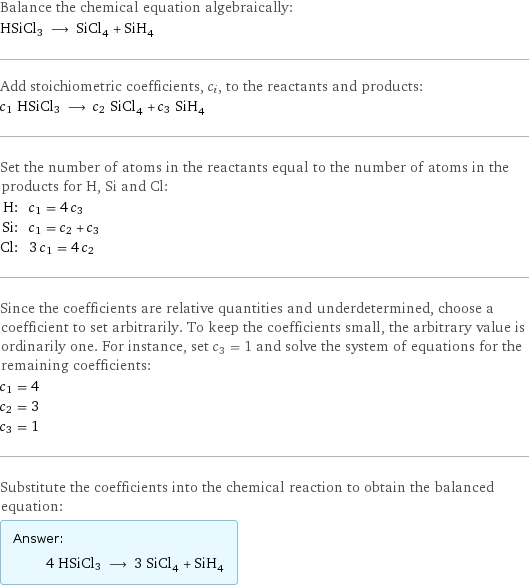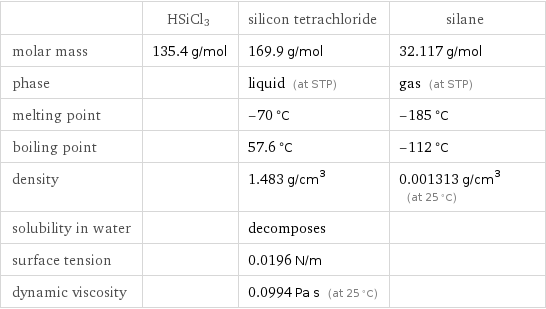Input interpretation

HSiCl3 ⟶ SiCl_4 silicon tetrachloride + SiH_4 silane
Balanced equation

Balance the chemical equation algebraically: HSiCl3 ⟶ SiCl_4 + SiH_4 Add stoichiometric coefficients, c_i, to the reactants and products: c_1 HSiCl3 ⟶ c_2 SiCl_4 + c_3 SiH_4 Set the number of atoms in the reactants equal to the number of atoms in the products for H, Si and Cl: H: | c_1 = 4 c_3 Si: | c_1 = c_2 + c_3 Cl: | 3 c_1 = 4 c_2 Since the coefficients are relative quantities and underdetermined, choose a coefficient to set arbitrarily. To keep the coefficients small, the arbitrary value is ordinarily one. For instance, set c_3 = 1 and solve the system of equations for the remaining coefficients: c_1 = 4 c_2 = 3 c_3 = 1 Substitute the coefficients into the chemical reaction to obtain the balanced equation: Answer: | | 4 HSiCl3 ⟶ 3 SiCl_4 + SiH_4
Structures

HSiCl3 ⟶ +
Names

HSiCl3 ⟶ silicon tetrachloride + silane
Equilibrium constant
![Construct the equilibrium constant, K, expression for: HSiCl3 ⟶ SiCl_4 + SiH_4 Plan: • Balance the chemical equation. • Determine the stoichiometric numbers. • Assemble the activity expression for each chemical species. • Use the activity expressions to build the equilibrium constant expression. Write the balanced chemical equation: 4 HSiCl3 ⟶ 3 SiCl_4 + SiH_4 Assign stoichiometric numbers, ν_i, using the stoichiometric coefficients, c_i, from the balanced chemical equation in the following manner: ν_i = -c_i for reactants and ν_i = c_i for products: chemical species | c_i | ν_i HSiCl3 | 4 | -4 SiCl_4 | 3 | 3 SiH_4 | 1 | 1 Assemble the activity expressions accounting for the state of matter and ν_i: chemical species | c_i | ν_i | activity expression HSiCl3 | 4 | -4 | ([HSiCl3])^(-4) SiCl_4 | 3 | 3 | ([SiCl4])^3 SiH_4 | 1 | 1 | [SiH4] The equilibrium constant symbol in the concentration basis is: K_c Mulitply the activity expressions to arrive at the K_c expression: Answer: | | K_c = ([HSiCl3])^(-4) ([SiCl4])^3 [SiH4] = (([SiCl4])^3 [SiH4])/([HSiCl3])^4](../image_source/02401456b476602e12f13ae203d5f7d0.png)
Construct the equilibrium constant, K, expression for: HSiCl3 ⟶ SiCl_4 + SiH_4 Plan: • Balance the chemical equation. • Determine the stoichiometric numbers. • Assemble the activity expression for each chemical species. • Use the activity expressions to build the equilibrium constant expression. Write the balanced chemical equation: 4 HSiCl3 ⟶ 3 SiCl_4 + SiH_4 Assign stoichiometric numbers, ν_i, using the stoichiometric coefficients, c_i, from the balanced chemical equation in the following manner: ν_i = -c_i for reactants and ν_i = c_i for products: chemical species | c_i | ν_i HSiCl3 | 4 | -4 SiCl_4 | 3 | 3 SiH_4 | 1 | 1 Assemble the activity expressions accounting for the state of matter and ν_i: chemical species | c_i | ν_i | activity expression HSiCl3 | 4 | -4 | ([HSiCl3])^(-4) SiCl_4 | 3 | 3 | ([SiCl4])^3 SiH_4 | 1 | 1 | [SiH4] The equilibrium constant symbol in the concentration basis is: K_c Mulitply the activity expressions to arrive at the K_c expression: Answer: | | K_c = ([HSiCl3])^(-4) ([SiCl4])^3 [SiH4] = (([SiCl4])^3 [SiH4])/([HSiCl3])^4
Rate of reaction
![Construct the rate of reaction expression for: HSiCl3 ⟶ SiCl_4 + SiH_4 Plan: • Balance the chemical equation. • Determine the stoichiometric numbers. • Assemble the rate term for each chemical species. • Write the rate of reaction expression. Write the balanced chemical equation: 4 HSiCl3 ⟶ 3 SiCl_4 + SiH_4 Assign stoichiometric numbers, ν_i, using the stoichiometric coefficients, c_i, from the balanced chemical equation in the following manner: ν_i = -c_i for reactants and ν_i = c_i for products: chemical species | c_i | ν_i HSiCl3 | 4 | -4 SiCl_4 | 3 | 3 SiH_4 | 1 | 1 The rate term for each chemical species, B_i, is 1/ν_i(Δ[B_i])/(Δt) where [B_i] is the amount concentration and t is time: chemical species | c_i | ν_i | rate term HSiCl3 | 4 | -4 | -1/4 (Δ[HSiCl3])/(Δt) SiCl_4 | 3 | 3 | 1/3 (Δ[SiCl4])/(Δt) SiH_4 | 1 | 1 | (Δ[SiH4])/(Δt) (for infinitesimal rate of change, replace Δ with d) Set the rate terms equal to each other to arrive at the rate expression: Answer: | | rate = -1/4 (Δ[HSiCl3])/(Δt) = 1/3 (Δ[SiCl4])/(Δt) = (Δ[SiH4])/(Δt) (assuming constant volume and no accumulation of intermediates or side products)](../image_source/fd40172fc07e708bf01b18d9b5d3d694.png)
Construct the rate of reaction expression for: HSiCl3 ⟶ SiCl_4 + SiH_4 Plan: • Balance the chemical equation. • Determine the stoichiometric numbers. • Assemble the rate term for each chemical species. • Write the rate of reaction expression. Write the balanced chemical equation: 4 HSiCl3 ⟶ 3 SiCl_4 + SiH_4 Assign stoichiometric numbers, ν_i, using the stoichiometric coefficients, c_i, from the balanced chemical equation in the following manner: ν_i = -c_i for reactants and ν_i = c_i for products: chemical species | c_i | ν_i HSiCl3 | 4 | -4 SiCl_4 | 3 | 3 SiH_4 | 1 | 1 The rate term for each chemical species, B_i, is 1/ν_i(Δ[B_i])/(Δt) where [B_i] is the amount concentration and t is time: chemical species | c_i | ν_i | rate term HSiCl3 | 4 | -4 | -1/4 (Δ[HSiCl3])/(Δt) SiCl_4 | 3 | 3 | 1/3 (Δ[SiCl4])/(Δt) SiH_4 | 1 | 1 | (Δ[SiH4])/(Δt) (for infinitesimal rate of change, replace Δ with d) Set the rate terms equal to each other to arrive at the rate expression: Answer: | | rate = -1/4 (Δ[HSiCl3])/(Δt) = 1/3 (Δ[SiCl4])/(Δt) = (Δ[SiH4])/(Δt) (assuming constant volume and no accumulation of intermediates or side products)
Chemical names and formulas

| HSiCl3 | silicon tetrachloride | silane formula | HSiCl3 | SiCl_4 | SiH_4 Hill formula | HCl3Si | Cl_4Si | H_4Si name | | silicon tetrachloride | silane IUPAC name | | tetrachlorosilane | silane
Substance properties

| HSiCl3 | silicon tetrachloride | silane molar mass | 135.4 g/mol | 169.9 g/mol | 32.117 g/mol phase | | liquid (at STP) | gas (at STP) melting point | | -70 °C | -185 °C boiling point | | 57.6 °C | -112 °C density | | 1.483 g/cm^3 | 0.001313 g/cm^3 (at 25 °C) solubility in water | | decomposes | surface tension | | 0.0196 N/m | dynamic viscosity | | 0.0994 Pa s (at 25 °C) |
Units
